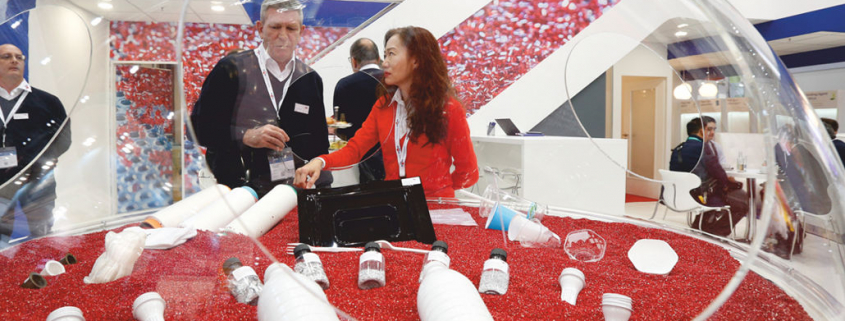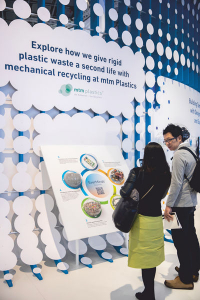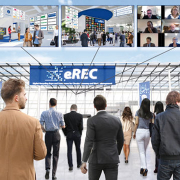K 2022: Trend Report Asia
On the occasion of the international trade fair K 2022, exhibition corporation Messe Düsseldorf provided a report on the ASEAN region.
According to the Düsseldorf trade show corporation, the world has experienced economic disruptions in the last two years, owing in part to Covid-19 pandemic-related containment measures that hampered mobility and resulted in reduced spending and consumption of goods and services. “The situation has put the world‘s supply chain resilience to the test, as it has inevitably resulted in demand and supply shocks.”
To mitigate the economic impact of the pandemic, a diversification in supply and demand has occurred to make it easier to obtain essential raw materials and components, as well as faster distribution of finished goods and access to skilled labor markets or manufacturing facilities. Manufacturers worldwide have either localized or regionalized their production to reduce or even eliminate their dependence on sources that are perceived as risky. China, the world’s second-largest economy, is at the center of the global value chain, because of its large market, extensive supply chain, large and efficient ports, and transportation networks, the exhibition corporation gave account. China had been hampered by the Covid-19 outbreak, debts, and a property downturn. Its expansion was expected to reach eight percent in 2021 before slowing to 5.1 percent in 2022. “Nonetheless, as markets stabilize, it is expected that growth will resume by 2023.”
From this year, the country’s imports and exports have managed to recover with trading partners such as the Association of Southeast Asian Nations – ASEAN (19.7 percent), the European Union (19.1 percent), and the USA (20.2 percent), while commerce with East Asian peers, Japan and South Korea, increased 9.4 percent and 18.4 percent, respectively. For manufacturing companies operating in the global market, the “China Plus One” initiative (a business strategy, in which multinational firms – in addition to China – are moving to other countries), would provide an opportunity to tap into Southeast Asia’s advancing industrial infrastructure to improve supply chain resiliency.
With the pandemic tapering off and more countries reopening, manufacturers would face new challenges such as high raw material and energy prices, logistical bottlenecks, and inflations, Messe Düsseldorf described the situation. At the same time, they were meeting consumers‘ low-cost demands and remaining consistent with technological advancements to readily reach economic viability. As well, digitalization would continue to play a vital part in keeping production, distribution efficiency, and closing the workforce gap.
Digitalization: 4IR and digital economy in ASEAN
The region of ASEAN, which includes Brunei, Cambodia, Indonesia, Laos, Malaysia, Myanmar, the Philippines, Singapore, Thailand, and Vietnam, is a large market with a population of 661.9 million people. The expanding trading bloc is the world’s fifth-largest economy with a total combined GDP (gross domestic product) of three trillion US-Dollar in 2020, after the USA with 20.9 trillion US-Dollar; China with 14.7 trillion US-Dollar; Japan with five trillion US-Dollar; and Germany with 3.8 trillion US-Dollar.
“The region has rallied behind the stringent containment measures and economic response during the pandemic. Trade has also been impacted by the pandemic, with imports and exports down eight percent in 2020 compared to the previous year.” In order to usher in the post-pandemic economic recovery in 2022, the ASEAN would have to consider taking more bold steps toward manufacturing hubs, green infrastructure, digital investments, talent reskilling, and high-value food industries. “Given how digitalization has helped businesses continue operations, despite contactless transactions, adoption of digital technology has become a must.” Most recently, Covid-19 had hastened the region’s digital shift, “as digital technology has proven to be a critical driver of economic activity during the pandemic”. To this end, the ASEAN Comprehensive Recovery Framework (ACRF), the region’s whole-of-community exit strategy to Covid-19 (launched at the 37th ASEAN Summit in November 2020), has sped up its digital transition, as digital technology has proven to be a critical driver of economic activity during the pandemic.
“Enabling the Fourth Industrial Revolution (4IR) can boost ASEAN’s competitiveness by increasing innovation, moving up value chains, creating jobs with better workforce capabilities and skills, lowering capital requirements, and increasing product customization,” Messe Düsseldorf wrote. ASEAN’s internet user base accounted for six percent of all internet users worldwide in 2010. In 2021, the number of internet users increased to 440 million, accounting for 75 percent of the region’s population. This would include 40 million users who first connected to the internet in 2021. ASEAN’s digital consumers have also increased by 60 million from 350 million since the pandemic. Furthermore, the emphasis on advanced manufacturing and the service sectors of the new economy bodes well for the growth of its digital economy.
The digital economy in ASEAN’s six largest markets – Indonesia, Malaysia, the Philippines, Singapore, Thailand, and Vietnam – is estimated to reach 309 billion US-Dollar by 2025, up from 32 billion US-Dollar in 2015, and collectively, is expected to reach 1 trillion US-Dollar by 2030.
Circular economy: cradle-to-cradle sustainability
According to the World Economic Forum, over 92 billion tons of materials were extracted and processed in 2019, representing roughly half of global carbon emissions. Efforts to reduce global carbon emissions are obviously impeded by the linear take-make-dispose cycle. Enforcing a circular economy, which is restorative, regenerative by design, and makes effective use of materials and energy to retain their value by reducing waste and using natural resources sustainably, could lead to economic benefits worth up to 4.5 trillion US-Dollar by 2030.
New product manufacturing from virgin materials can produce 22.8 billion tons/year of emissions, Messe Düsseldorf informed. Circular economy strategies could nearly double the number of materials reused, from 8.6 percent to 17 percent, while limiting the use of virgin materials. “However, the circular economy has not been applied because the percentage of products and materials that are reused is decreasing, while CO2 emissions from natural resource extraction and processing, which account for roughly half of all current GHG emissions, are increasing. By 2050, raw material demand is expected to double.” ASEAN, which is still in its early stages of adopting the circular economy, is coming to grips with resource depletion, unsustainable raw material consumption, flaws in product value chains, and climate change, all of which are affecting the region‘s economic growth.
Furthermore, the region is plagued by the consequences of poor waste management. According to the United Nations‘ ASEAN waste management report in 2017, Indonesia generated 64 million tons of municipal solid waste (MSW). Thailand produced an estimated 26.8 million tons/year and Vietnam an estimated 22 million tons/year of waste.
Recycling: boosting value recovery of plastics
Less than 25 percent of plastics available for reuse were recycled into valuable materials in Malaysia, the Philippines, and Thailand, the trade fair organization referred to a World Bank report on Southeast Asia’s plastic circularity. More than 75 percent of the material value of the plastics was lost, equating to six billion US-Dollar per year across the three countries, due to improper waste management and poor recycling of single-use plastics. “Malaysia, which is home to about 1,300 plastic manufacturers, has a low recycling rate, owing to its recycling industry’s focus on materials like transparent PET bottles, which are easy to collect and have a high value. A vast bulk of waste, such as food packaging, polystyrene products and straws, go unrecycled due to lack of technology and unappealing profitability.” Moreover, there was a lack of local demand for recycled plastic as global oil prices (which affect the prices of virgin plastics) have remained volatile. Recycled plastics had to be 15 to 30 percent cheaper than virgin resins in order to be competitive. “According to a World Bank country study that took into account the widely used and produced plastic resins, Malaysia loses 81 percent of the material value of PET, PP, HDPE, and LDPE plastics. These recyclable plastics are primarily used for single-use packaging.” Meanwhile, PVC, which is also widely used in the country’s building and construction industries, had longer application lifetimes of up to 20 years and was typically treated as construction and demolition (C&D) waste, and thus, handled better.
As reported, in response, Malaysia developed the country’s “Roadmap Towards Zero Single-Use Plastics 2018-2030”, a comprehensive policy framework to regulate the use of disposable plastics, and increase the uptake of biodegradable and compostable products including single-use medical devices and consumer products. It also contains a Federal pollution levy on plastic manufacturers, which was set to begin in 2022. Furthermore, more R&D funding would be directed toward the development of alternative eco-friendly products.
The Philippines is supposed to be responsible for an estimated 0.75 million tons/year of mismanaged plastics entering the ocean. However, the country is working to increase its plastic recycling rate, which is currently at 22 percent. With 78 percent of unrecovered material value, the country’s economy loses approximately 790-890 million US-Dollar per year. In 2019, only 28 percent, or 292,000 tons of the 1.1 million tons/year of key resins consumed (including PET, PP, HDPE, and LLDPE/ LDPE) were recycled. PET (excluding polyester applications) has the highest recycling rate in packaging, at 45 percent.
Meanwhile, LDPE/LLDPE – used in a variety of applications such as electronics, automotive, and construction packaging sectors – are the least collected and recycled, since they have longer usage cycles, thus making collection difficult. On the other hand, the market for post-consumer plastics such as PET bottles has encouraged collection and recycling.
“To close this recycling gap, several obstacles must be overcome, including high logistics costs, which prevent recyclers from sourcing feedstock locally; energy costs, which are up to 67 percent higher than regional peers like Thailand and Vietnam, reducing profitability for most recyclers that use low-efficiency equipment,” Messe Düsseldorf wrote. “Also on the agenda are the recycling mix, which contains a high proportion of low-value and difficult-to-recycle plastics, plus a lack of incentives to invest in more efficient recycling mechanisms and recyclers‘ inability to meet market demand for quality and scale; oil prices.”
Thailand – which has a plastics industry that accounted for 6.1 percent of its GDP in 2019 – is focusing on plastic waste management as part of its efforts to strengthen trade. In 2018, it consumed 3.49 million tons of plastics/year (42 percent of this amount was used for packaging) and recycled only 17.6 percent to 616,000 tons/year of key plastic resins. According to the information, this practice resulted in an 87 percent material value loss amounting to around four billion US-Dollar per year. PET had the highest recycling rate (46 percent) of the resin types.
Thailand’s “National Plastic Waste Management Roadmap 2018-2030” aims to recycle all plastics to boost material value recovery. “This can be accomplished by increasing the efficiency of post-consumer plastic waste collection and sorting, as well as mechanical and chemical recycling capacities; setting recycled content targets across all major end-use applications; mandating ‘design for recycling’ standards, and implementing waste management policies.”
(Published in GLOBAL RECYCLING Magazine 2/2022, Page 20, Photo: Messe Düsseldorf, Constanze Tillmann)










